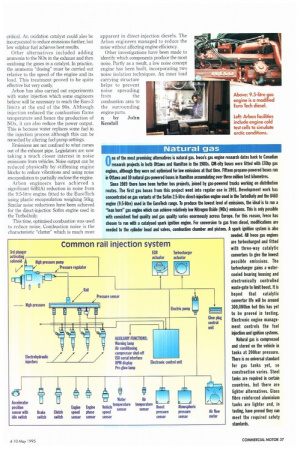Natural gas
Page 49

If you've noticed an error in this article please click here to report it so we can fix it.
Common rail injection system
MR Turbocharger
actuator actuator
0
One of the most promising alternatives is natural gas. Iveco's gas engine research dates back to Canadian research projects in both Ottawa and Hamilton in the 1980s. GM-city buses were fitted with llOhp gas engines, although they were not optimised for low emissions at that time. Fifteen propane-powered buses ran
in Ottawa and 10 natural gas-powered buses in Hamilton accumulating over three million test kilometres.
Since 1989 there have been further bus projects, joined by gas-powered trucks working on distribution routes. The first gas buses from this project went into regular use in 1991. Development work has concentrated on gas variants of the Sofim 23-litre direct-injection engine used in the TurboDaily and the 8460 engine (9.5-litre) used in the EuroTech range. To produce the lowest level of emissions, the ideal is to run a "lean burn" gas engine which can achieve relatively low Nitrogen Oxide (NOx) emissions. This is only possible with consistent fuel quality and gas quality varies enormously across Europe. For this reason, lveco has chosen to run with a catalysed spark ignition engine. For conversion to gas from diesel, modifications are needed to the cylinder head and valves, combustion chamber and pistons. A spark ignition system is also needed. All lveco gas engines are turbocharged and fitted with three-way catalytic convertors to give the lowest possible emissions. The turbocharger gains a watercooled bearing housing and electronically controlled waste-gate to limit boost. It is hoped that catalytic convertor life will be around 300,000km but this has yet to be proved in testing. Electronic engine management controls the fuel injection and ignition systems.
Natural gas is compressed and stored on the vehicle in tanks at Mbar pressure. There is no universal standard for gas tanks yet, so construction varies. Steel tanks are required in certain countries, but there are lighter alternatives. Glass fibre reinforced aluminium tanks are lighter and, in testing, have proved they can meet the required safety standards.
















































































































